Advertisements
Chapters
![Selina solutions for Concise Physics [English] Class 9 ICSE chapter 2 - Motion in One Dimension Selina solutions for Concise Physics [English] Class 9 ICSE chapter 2 - Motion in One Dimension - Shaalaa.com](/images/concise-physics-english-class-9-icse_6:8a0c4572dea049a29e575abe2d9ca662.jpg)
Advertisements
Solutions for Chapter 2: Motion in One Dimension
Below listed, you can find solutions for Chapter 2 of CISCE Selina for Concise Physics [English] Class 9 ICSE.
Selina solutions for Concise Physics [English] Class 9 ICSE 2 Motion in One Dimension Exercise
A body starts to slide over a horizontal surface with an initial velocity of 0.5 ms−1. Due to friction, its velocity decreases at the rate of 0.05 ms−2. How much time will it take for the body to stop?
Selina solutions for Concise Physics [English] Class 9 ICSE 2 Motion in One Dimension Exercise 2 (A) [Page 35]
Differentiate between the scalar and vector quantities, giving two examples of each.
State whether the following quantity is a scalar or vector.
- Pressure
- Force
- Momentum
- Energy
- Weight
- Speed
When is a body said to be at rest?
When is a body said to be in motion?
What do you mean by motion in one direction?
Define displacement. State its unit.
Differentiate between distance and displacement.
Can displacement be zero even if the distance is not zero? Give one example to explain your answer.
When is the magnitude of displacement equal to the distance?
Define velocity. State its unit.
Define speed. What is its S.I. unit?
Distinguish between speed and velocity.
Which of the quantity-speed or velocity-gives the direction of motion of a body?
When is instantaneous speed the same as the average speed?
Distinguish between uniform velocity and variable velocity.
Distinguish between average speed and average velocity.
Give an example of the motion of a body moving with a constant speed but with a variable velocity. Draw a diagram to represent such a motion.
Give an example of motion in which the average speed is not zero but the average velocity is zero.
Define acceleration. State its unit.
Distinguish between acceleration and retardation.
Differentiate between uniform acceleration and variable acceleration.
What is meant by the term retardation? Name its S.I. unit.
Which of the quantity-velocity or acceleration-determines the direction of motion?
Give one example of following motion :
Uniform velocity
Give one example of following motion :
Variable velocity
Give one example of following motion :
Variable acceleration
Give one example of the following motion:
Uniform retardation
The diagram below shows the pattern of the oil on the road at a constant rate from a moving car. What information do you get from it about the motion of the car.

Define the term acceleration due to gravity. State its average value.
'The value of g remains the same at all places on the Earth's surface'. Is this statement true? Give reason for your answer.
If a stone and a pencil are dropped simultaneously in vacuum from the top of a tower, then which of the two will reach the ground first? Give reason.
Selina solutions for Concise Physics [English] Class 9 ICSE 2 Motion in One Dimension Exercise 2 (A) [Pages 35 - 36]
The vector quantity is :
Work
Pressure
Distance
velocity
The S.I. unit of velocity is ___________
km h-1
m min-1
km rnin-1
m s-1
The unit of retardation is ____________
m s-1
m s-2
m
m s2
A body when projected up with an initial velocity u goes to a maximum height h in time t and then comes back at the point of projection. The correct statement is ______________
The average velocity is 2 h/t.
The acceleration is zero.
The final velocity on reaching the point of projection is 2 u.
The displacement is zero.
18 km h-1 is equal to _____________
10 m s-1
5 m s-1
18 m s-1
1.8 m s-1
Selina solutions for Concise Physics [English] Class 9 ICSE 2 Motion in One Dimension Exercise 2 (A) [Page 36]
The speed of a car is 72 km h-1. Express it in m s-1.
Express 15 m s-1 in km h-1.
Express the following in m s-1.
1 km h-1
Express the following in m s-1.
18 km min-1
Arrange the following speeds in increasing order.
10 m s-1, 1 km min-1 and 18 km h-1.
A train takes 3 h to travel from Agra to Delhi with a uniform speed of 65 km h-1. Find the distance between the two cities.
A car travels the first 30 km with a uniform speed of 60 km h-1 and the next 30 km with a uniform speed of 40 km h-1. Calculate :
The total time of journey,
The average speed of the car.
A train takes 2 h to reach station B from station A, and then 3 h to return from station B to station A. The distance between the two stations is 200 km. Find:
The average speed,
The average velocity of the train.
A car moving on a straight path covers a distance of 1 km due east in 100 s. What is the speed of the car?
A car moving on a straight path covers a distance of 1 km due east in 100 s. What is velocity of the car?
A body starts from rest and acquires a velocity 10 m s-1 in 2 s. Find the acceleration.
A car starting from rest acquires a velocity 180m s-1 in 0.05 h. Find the acceleration.
A body is moving vertically upwards. Its velocity changes at a constant rate from 50 m s-1 to 20 m s-1 in 3 s. What is its acceleration?
A toy car initially moving with uniform velocity of 18 km h-1 comes to a stop in 2 s. Find the retardation of the car in S.I. units.
A car accelerates at a rate of 5 m s-2. Find the increase in its velocity in 2 s.
A car is moving with a velocity 20 m s-1. The brakes are applied to retard it at a rate of 2 m s-2. What will be the velocity after 5 s of applying the brakes?
A bicycle initially moving with a velocity 5.0 m s-1 accelerates for 5 s at a rate of 2 m s-2. What will be its final velocity?
A car is moving in a straight line with speed 18 km h-1. It is stopped in 5 s by applying the brakes. Find:
- the speed of car in m s-1
- the retardation and
- the speed of car after 2 s of applying the brakes.
Selina solutions for Concise Physics [English] Class 9 ICSE 2 Motion in One Dimension Exercise 2 (B) [Pages 47 - 48]
For the motion with uniform velocity , how is the distance travelled related to the time ?
What information about the motion of a body are obtained from the displacement-time graph?
What does the slope of a displacement-time graph represent?
Can displacement-time sketch be parallel to the displacement axis? Give a reason to your answer.
Draw a displacement-time graph for a boy going to school with uniform velocity.
State how the velocity-time graph can be used to find
The acceleration of a body
State how the velocity-time graph can be used to find The distance travelled by the body in a given time
State how the velocity-time graph can be used to find The displacement of the body in a given time.
What can you say about the nature of motion of a body if its displacement-time graph is A straight line parallel to the time axis?
What can you say about the nature of motion of a body if its displacement-time graph is A straight line inclined to the time axis with an acute angle?
What can you say about the nature of motion of a body if its displacement-time graph is A straight line inclined to the time axis with an obtuse angle?
What can you say about the nature of motion of a body if its displacement-time graph is A curve.
Figure shows the displacement-time graph of two vehicles A and B moving along a straight road. Which vehicle is moving faster? Give reason.

State the type of motion represented by the following sketches in Figures.
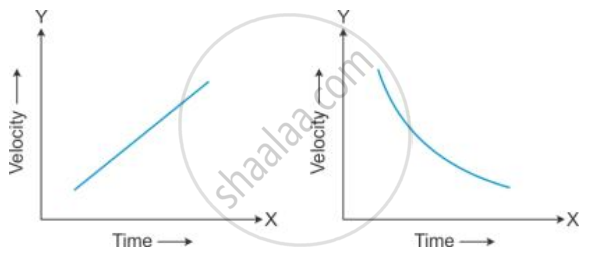
Give an example of each type of motion.
Draw a velocity-time graph for a body moving with an initial velocity u and uniform acceleration a. Use this graph to find the distance travelled by the body in time t.
What does the slope of velocity-time graph represent?
Figure shows the velocity-time graphs for two cars A and B moving in the same direction. Which car has greater acceleration? Give reasons to your answer.
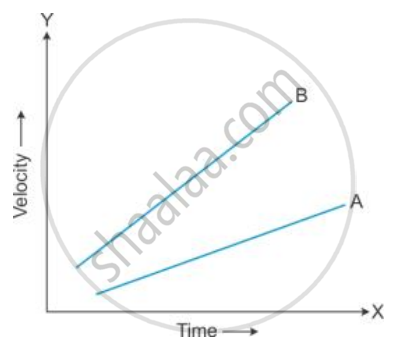
Draw the shape of the velocity-time graph for a body moving with (a) Uniform velocity and (b) Uniform acceleration.
The velocity-time graph for a uniformly retarded body is a straight line inclined to the time axis with an obtuse angle. How is retardation calculated from the velocity-time graph?
The figure shows the displacement - time graph for four bodies A, B C and D. In each case state what information do you get about the acceleration (zero, positive or negative).

Draw a graph for acceleration against time for a uniformly accelerated motion. How can it be used to find the change in speed in a certain interval of time?
Draw a velocity-time graph for the free fall of a body under gravity starting from rest. Take g = 10m s-2
How is the distance related with time for motion under uniform acceleration such as the motion of a freely falling body?
A body falls freely from a certain height. Show graphically the relation between the distance fallen and square of time. How will you determine g from this graph?
Selina solutions for Concise Physics [English] Class 9 ICSE 2 Motion in One Dimension Exercise 2 (B) [Page 48]
The velocity-time graph of a body in motion is a straight line inclined to the time axis. The correct statement is ___________
Velocity is uniform
Acceleration is uniform
Both velocity and acceleration are uniform
Neither velocity nor acceleration is uniform.
For a uniformly retarded motion, the velocity-time graph is _____________
A curve
A straight line parallel to the time axis
A straight line perpendicular to the time axis
A straight line inclined to the time axis
For uniform motion _________
The distance-time graph is a straight line parallel to the time axis.
The speed-time graph is a straight line inclined to the time axis.
The speed-time graph is a straight line parallel to the time axis.
The acceleration-time graph is a straight line parallel to the time axis.
Selina solutions for Concise Physics [English] Class 9 ICSE 2 Motion in One Dimension Exercise 2 (B) [Pages 49 - 50]
Figure (a) shows the displacement-time graph for the motion of a body. Use it to calculate the velocity of the body at t = 1 s, 2 s and 3 s, and then draw the velocity-time graph in Figure (b) for it.
 |
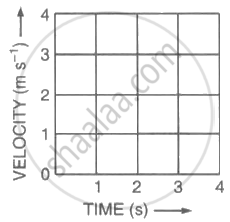 |
| (a) | (b) |
The following table gives the displacement of a car at different instants of time.
| Time (s) | 0 | 1 | 2 | 3 | 4 |
| Displacement (m) | 0 | 5 | 10 | 15 | 20 |
- Draw the displacement-time sketch and find the average velocity of the car.
- What will be the displacement of the car at (i) 2.5 s and (ii) 4.5 s?
A body is moving in a straight line and its displacement at various instants of time is given in the following table
| Time (s) | 0 | 1 | 2 | 3 | 4 | 5 | 6 | 7 |
| Displacement (m) | 2 | 6 | 12 | 12 | 12 | 18 | 22 | 24 |
Plot the displacement-time graph and calculate
(i) Total distance travelled in the interval 1 s to 5 s.
(ii) Average velocity in time interval 1 s to 5 s.
Figure shows the displacement of a body at different times .
Calculate the velocity of the body as it moves for time interval :
(i) 0 to 5 s,
(ii) 5 s to 7 s
(iii) 7 s to 9 s.

Figure shows the displacement of a body at different times .

Calculate the average velocity during the time interval 5 s to 9 s ,
[Hint : From 5 s to 9 s , displacement = 7 m - 3m = 4m]
From the displacement-time graph of a cyclist given below in the Figure, find The average velocity in the first 4 s.

From the displacement-time graph of a cyclist given below in the Figure, find The displacement from the initial position at the end of 10 s,

From the displacement-time graph of a cyclist given below in the Figure, find The time after which he reaches the starting point .

Figure ahead represents the displacement - time sketch of motion of two cars A and B . Find :
(i) the distance by which the car B was initially ahead of car A.
(ii) the velocities of car A and car B.
(iii) the time in which car A catches car B.
(iv) the distance from start when the car A will catch the car B.
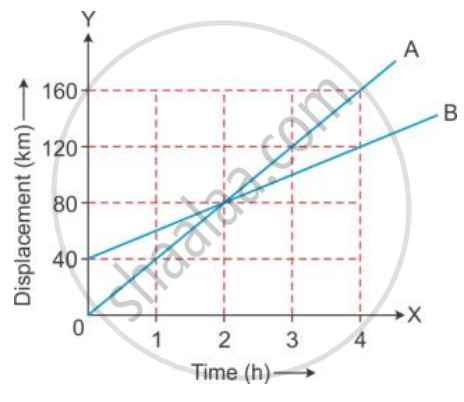
A body at rest is made to fall from the top of a tower. Its displacement at different instants is given in the following table:
| Time (in s) | 0.1 | 0.2 | 0.3 | 0.4 | 0.5 | 0.6 |
| Displacement (in m) | 0.05 | 0.20 | 0.45 | 0.80 | 1.25 | 1.80 |
Draw a displacement-time graph and state whether the motion is uniform or non-uniform?
Figure (a) shows the velocity-time graph for the motion of a body. Use it to find the displacement of the body at t = 1 s, 2 s, 3 s and 4 s, then draw on Figure (b), the displacement-time graph for it.
 |
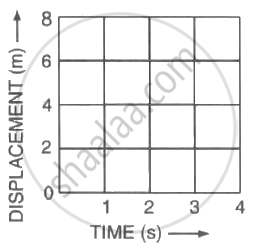 |
| (a) | (b) |
Figure given below shows a velocity-time graph for a car starting from rest. The graph has three parts AB, BC and CD.

State how is the distance travelled in any part determined from this graph .
Figure given below shows a velocity-time graph for a car starting from rest. The graph has three parts AB, BC and CD.

Compare the distance travelled in part BC with the distance travelled in part AB.
Figure given below shows a velocity-time graph for a car starting from rest. The graph has three parts AB, BC and CD.

Which part of graph shows motion with uniform
(a) velocity (b) acceleration (c) retardation ?
Figure given below shows a velocity-time graph for a car starting from rest. The graph has three parts AB, BC and CD.

(a) Is the magnitude of acceleration higher or lower than that of retardation ? Give a reason .
(b) Compare the magnitude of acceleration and retardation .
The velocity-time graph of a moving body is given below in Figure
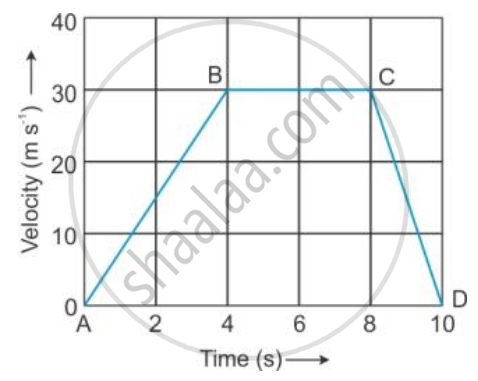
The acceleration in parts AB, BC and CD.
The velocity-time graph of a moving body is given below in Figure
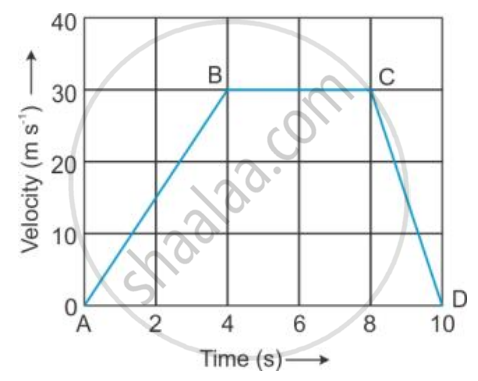
Displacement in each part AB, BC and CD.
The velocity-time graph of a moving body is given below in Figure
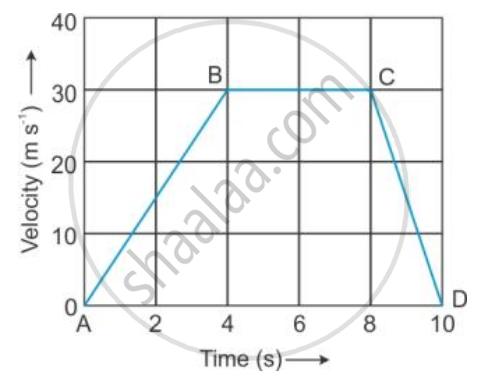
Total displacement.
A ball moves on a smooth floor in a straight line with uniform velocity 10 m s-1 for 6 s. At t = 6 s, the ball hits a wall and comes back along the same line to the starting point with the same speed. Draw the velocity-time graph and use it to find the total distance travelled by the ball and its displacement.
Figure shows the velocity-time graph of a particle moving in a straight line.
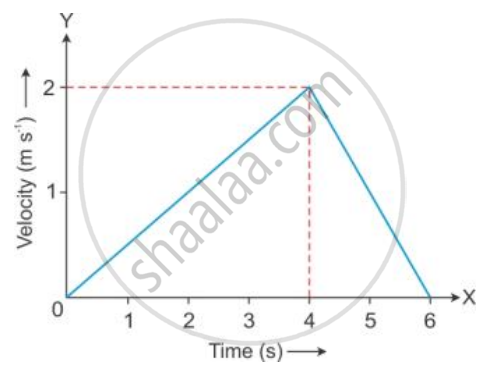
(i) State the nature of motion of particle.
(ii) Find the displacement of particle at t = 6 s.
(iii) Does the particle change its direction of motion?
(iv) Compare the distance travelled by the particle from 0 to 4 s and from 4 s to 6 s.
(v) Find the acceleration from 0 to 4 s and retardation from 4 s to 6 s.
Selina solutions for Concise Physics [English] Class 9 ICSE 2 Motion in One Dimension Exercise 2 (C) [Page 54]
Write three equations of uniformly accelerated motion relating the initial velocity (u), final velocity (v), time (t), acceleration (a) and displacement (S).
Derive the following equations for uniformly accelerated motion:
(i) v = u + at
(ii) `"S = ut" + 1/2 "at"^2`
(iii) v2 = u2 + 2aS
where the symbols have their usual meanings.
Write an expression for the distance S covered in time t by a body which is initially at rest and starts moving with a constant acceleration a.
Selina solutions for Concise Physics [English] Class 9 ICSE 2 Motion in One Dimension Exercise 2 (C) [Page 54]
The correct equation of motion is : ___________
v = u + aS
v = ut + a
`"S" = ut + 1/2 at`
v = u + at
A car starting from rest accelerates uniformly to acquire a speed 20 km h-1 in 30 min. The distance travelled by a car in this time interval will be _____________
600 km
5 km
6 km
10 km
Selina solutions for Concise Physics [English] Class 9 ICSE 2 Motion in One Dimension Exercise 2 (C) [Pages 54 - 55]
A body starts from rest with uniform acceleration 2 m s-2. Find the distance covered by the body in 2 s.
A body starts with an initial velocity of 10m s-1 and acceleration 5 m s-2. Find the distance covered by it in 5 s.
A vehicle is accelerating on a straight road. Its velocity at any instant is 30 km/h. After 2 s, it is 33.6 km/h, and after further 2 s, it is 37.2 km/h. Find the acceleration of the vehicle in m s-2. Is the acceleration uniform?
A body, initially at rest, starts moving with a constant acceleration 2 m s-2. Calculate: (i) the velocity acquired and (ii) the distance travelled in 5 s.
A bullet initially moving with a velocity 20 m/s strikes a target and comes to rest after penetrating a distance 10 cm into the target. Calculate the retardation caused by the target.
A train moving with a velocity of 20 m s-1 is brought to rest by applying brakes in 5 s. Calculate the retardation.
A train travels with a speed of 60 km h-1 from station A to station B and then comes back with a speed 80 km h-1 from station B to station A. Find -
- The average speed
- The average velocity of the train.
A train is moving with a velocity of 90 km h-1 . It is brought to stop by applying the brakes which produce a retardation of 0.5 ms-2 Find :
(i) The velocity after 10 s , and
(ii) the time taken by the train to come to rest .
A car travels a distance 100 m with constant acceleration and average velocity of 20 ms-1. The final velocity acquired by the car is 25 ms-1.
Find
(i) The initial velocity.
(ii) Acceleration of the car.
When brakes are applied to a bus, retardation produced is 25 cm s-2 and the bus takes 20 s to stop. Calculate -
- The initial velocity of the bus
- The distance travelled by bus during this time.
A body moves from rest with uniform acceleration and travels 270 m in 3 s. Find the velocity of the body at 10 s after the start.
A body moving with a constant acceleration travels distances 3 m and 8 m, respectively in 1 s and 2 s. Calculate:
- The initial velocity.
- The acceleration of body.
A car travels with uniform velocity of 25 m s-1 for 5 s. The brakes are then applied and the car is uniformly retarded and comes to rest in further 10 s. Find:
- The distance which the car travels before the brakes are applied,
- Retardation and
- The distance travelled by car after applying the brakes.
A space craft flying in a straight course with velocity of 75 km s-1 fires its rocket motors for 6.0 s. At the end of this time its speed is 120 km s-1 in the same direction.
Find
(i) The space craft's average acceleration while the motors were firing
(ii) The distance travelled by the space craft in the first 10 s after the rocket motors were started, the motors being in action for only 6 s.
A train starts from rest and accelerates uniformly at a rate of 2 m s-2 for 10 s. It then maintains a constant speed for 200 s. The brakes are then applied and the train is uniformly retarded and comes to rest in 50 s. Find
(i) The maximum velocity reached,
(ii) The retardation in the last 50 s,
(iii) The total distance travelled,
(iv) The average velocity of the train.
Solutions for 2: Motion in One Dimension
![Selina solutions for Concise Physics [English] Class 9 ICSE chapter 2 - Motion in One Dimension Selina solutions for Concise Physics [English] Class 9 ICSE chapter 2 - Motion in One Dimension - Shaalaa.com](/images/concise-physics-english-class-9-icse_6:8a0c4572dea049a29e575abe2d9ca662.jpg)
Selina solutions for Concise Physics [English] Class 9 ICSE chapter 2 - Motion in One Dimension
Shaalaa.com has the CISCE Mathematics Concise Physics [English] Class 9 ICSE CISCE solutions in a manner that help students grasp basic concepts better and faster. The detailed, step-by-step solutions will help you understand the concepts better and clarify any confusion. Selina solutions for Mathematics Concise Physics [English] Class 9 ICSE CISCE 2 (Motion in One Dimension) include all questions with answers and detailed explanations. This will clear students' doubts about questions and improve their application skills while preparing for board exams.
Further, we at Shaalaa.com provide such solutions so students can prepare for written exams. Selina textbook solutions can be a core help for self-study and provide excellent self-help guidance for students.
Concepts covered in Concise Physics [English] Class 9 ICSE chapter 2 Motion in One Dimension are Types of Velocity, Types of Acceleration, Types of Speed, Scalar and Vector Quantities, Velocity - Time Graphs, Measuring the Rate of Motion - Speed with Direction, Distance and Displacement, Acceleration and Retardation, Rate of Change of Velocity, Motion and Rest, Motion Along a Straight Line, Speed, Velocity, Distinguish Between Speed and Velocity, Acceleration Due to Gravity (Earth’s Gravitational Acceleration), Graphical Representation of Motion, Displacement - Time Graph Or Distance - Time Graph, Acceleration - Time Graph, Motion Under Gravity, Equations of Motion by Graphical Method, Derivation of Velocity - Time Relation by Graphical Method.
Using Selina Concise Physics [English] Class 9 ICSE solutions Motion in One Dimension exercise by students is an easy way to prepare for the exams, as they involve solutions arranged chapter-wise and also page-wise. The questions involved in Selina Solutions are essential questions that can be asked in the final exam. Maximum CISCE Concise Physics [English] Class 9 ICSE students prefer Selina Textbook Solutions to score more in exams.
Get the free view of Chapter 2, Motion in One Dimension Concise Physics [English] Class 9 ICSE additional questions for Mathematics Concise Physics [English] Class 9 ICSE CISCE, and you can use Shaalaa.com to keep it handy for your exam preparation.
